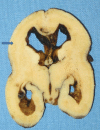Prenatal Diagnosis of Lissencephaly Type 2 using Three-dimensional Ultrasound and Fetal MRI: Case Report and Review of the Literature
- PMID: 27088705
- PMCID: PMC10309364
- DOI: 10.1055/s-0036-1582126
Prenatal Diagnosis of Lissencephaly Type 2 using Three-dimensional Ultrasound and Fetal MRI: Case Report and Review of the Literature
Abstract
Lissencephaly is a genetic heterogeneous autosomal recessive disorder characterized by the classical triad: brain malformations, eye anomalies, and congenital muscular dystrophy. Prenatal diagnosis is feasible by demonstrating abnormal development of sulci and gyri. Magnetic resonance imaging (MRI) may enhance detection of developmental cortical disorders as well as ocular anomalies. We describe a case of early diagnosis of lissencephaly type 2 detected at the time of routine second trimester scan by three-dimensional ultrasound and fetal MRI. Gross pathology confirmed the accuracy of the prenatal diagnosis while histology showed the typical feature of cobblestone cortex. As the disease is associated with poor perinatal prognosis, early and accurate prenatal diagnosis is important for genetic counseling and antenatal care.
Resumo: Lissencefalia são doenças genéticas autossômicas recessivas heterogêneas caracterizadas pela tríade clássica: malformações do cérebro, anomalias oculares e distrofia muscular congênita. Diagnóstico pré-natal é factível pela demonstração do desenvolvimento anormal de sulcos e giros. Ressonância magnética (RM) melhora a detecção de distúrbios do desenvolvimento cortical, bem como as anomalias oculares. Descrevemos um caso de diagnóstico precoce de lisencefalia tipo 2 detectado no momento do ultrassom morfológico de segundo trimestre pela ultrassonografia tridimensional e RM fetal. A macroscopia confirmou a acurácia do diagnóstico pré-natal, enquanto que a microscopia mostrou a típica característica de córtex em cobblestone. Como a doença está associada à um pobre prognóstico perinatal, o precoce e acurado diagnóstico pré-natal é importante para o aconselhamento genético e seguimento da gestação.
Thieme Publicações Ltda Rio de Janeiro, Brazil.
Figures




Similar articles
-
Development of fetal brain sulci and gyri: assessment through two and three-dimensional ultrasound and magnetic resonance imaging.Arch Gynecol Obstet. 2011 Feb;283(2):149-58. doi: 10.1007/s00404-010-1691-y. Epub 2010 Sep 28. Arch Gynecol Obstet. 2011. PMID: 20878170 Review.
-
Prenatal diagnosis of cobblestone lissencephaly associated with Walker-Warburg syndrome based on a specific sonographic pattern.Ultrasound Obstet Gynecol. 2016 Jan;47(1):117-22. doi: 10.1002/uog.15735. Ultrasound Obstet Gynecol. 2016. PMID: 26315758
-
Prenatal diagnosis of lissencephaly: A case report.Vojnosanit Pregl. 2016 Jan;73(1):77-82. doi: 10.2298/vsp140806010c. Vojnosanit Pregl. 2016. PMID: 26964389
-
Prenatal diagnosis of microcephaly with simplified gyral pattern: series of eight cases.Ultrasound Obstet Gynecol. 2024 Feb;63(2):271-275. doi: 10.1002/uog.27450. Epub 2024 Jan 11. Ultrasound Obstet Gynecol. 2024. PMID: 37551048
-
Outcome of fetuses with congenital cytomegalovirus infection and normal ultrasound at diagnosis: systematic review and meta-analysis.Ultrasound Obstet Gynecol. 2021 Apr;57(4):551-559. doi: 10.1002/uog.23143. Epub 2021 Mar 9. Ultrasound Obstet Gynecol. 2021. PMID: 33030767
Cited by
-
Coexisting Congenital Mesoblastic Nephroma and Lissencephaly: Unique Case Report with Pathological Analysis and Its Clinical Significance.Biomedicines. 2025 Jan 15;13(1):196. doi: 10.3390/biomedicines13010196. Biomedicines. 2025. PMID: 39857780 Free PMC article.
-
Cobblestone lissencephaly (Type II), clinical, and neuroimaging: A case report and literature review.Radiol Case Rep. 2024 Aug 12;19(11):4794-4803. doi: 10.1016/j.radcr.2024.07.043. eCollection 2024 Nov. Radiol Case Rep. 2024. PMID: 39228958 Free PMC article.
-
Role of Physiotherapy in Pediatric Lissencephaly: A Case Report and Therapeutic Insights.Cureus. 2024 Jun 22;16(6):e62901. doi: 10.7759/cureus.62901. eCollection 2024 Jun. Cureus. 2024. PMID: 39040723 Free PMC article.
-
Development of the prosencephalic structures, ganglionic eminence, basal ganglia and thalamus at 11 + 3 to 13 + 6 gestational weeks on 3D transvaginal ultrasound including normative data.Brain Struct Funct. 2023 Dec;228(9):2089-2101. doi: 10.1007/s00429-023-02679-y. Epub 2023 Sep 15. Brain Struct Funct. 2023. PMID: 37712966 Free PMC article.
-
A prenatal case of lissencephaly with cerebellar hypoplasia: New mutation in RELN gene.Clin Case Rep. 2021 Dec 5;9(12):e04882. doi: 10.1002/ccr3.4882. eCollection 2021 Dec. Clin Case Rep. 2021. PMID: 34917359 Free PMC article.
References
-
- Walker W. Lissencephaly. Arch Neurol Psychiatry. 1942;48(1):13–29.
-
- Monteagudo A, Alayón A, Mayberry P. Walker-Warburg syndrome: case report and review of the literature. J Ultrasound Med. 2001;20(4):419–426. - PubMed
-
- Blin G, Rabbé A, Ansquer Y, Meghdiche S, Floch-Tudal C, Mandelbrot L. First-trimester ultrasound diagnosis in a recurrent case of Walker-Warburg syndrome. Ultrasound Obstet Gynecol. 2005;26(3):297–299. - PubMed
Publication types
MeSH terms
LinkOut - more resources
Full Text Sources
Other Literature Sources
Medical
Research Materials
